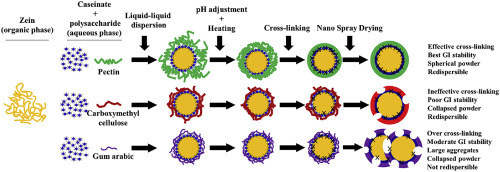当前位置:
X-MOL 学术
›
Food Hydrocoll.
›
论文详情
Our official English website, www.x-mol.net, welcomes your
feedback! (Note: you will need to create a separate account there.)
Caseinate-zein-polysaccharide complex nanoparticles as potential oral delivery vehicles for curcumin: Effect of polysaccharide type and chemical cross-linking
Food Hydrocolloids ( IF 11.0 ) Pub Date : Chao Chang, Taoran Wang, Qiaobin Hu, Yangchao Luo
Food Hydrocolloids ( IF 11.0 ) Pub Date : Chao Chang, Taoran Wang, Qiaobin Hu, Yangchao Luo

|
The formation of protein-polysaccharide complex nanoparticles was investigated using caseinate (NaCas), zein, and three polysaccharides, i.e. pectin, carboxymethyl cellulose (CMC) and gum arabic. Their complexation behavior was examined by dynamic light scattering, Fourier transform infrared and fluorescence spectroscopy. Chemical cross-linker, 1-ethyl-3-(3-dimethyl aminopropyl) carbodiimide/N-hydroxysuccinimide, were exploited to covalently bridge proteins and polysaccharide to improve the stability of complex nanoparticles in simulated gastrointestinal (GI) fluids. Curcumin was studied as a model lipophilic nutrient to explore the encapsulation and delivery applications. The polysaccharide type significantly affected the cross-linking efficiency which led to distinctive physical stability under simulated GI conditions and completely different morphology of powders obtained by nano spray drying, as well as their redispersibility in water. Compared to gum arabic, pectin and CMC were more favorable to form cross-linked nanoparticles with smaller size (160–210 nm), uniform distribution, spherical shape, higher encapsulation efficiency (up to 80%), slower release and much improved antioxidant activity, as well as exceptional redispersibility after drying. Our study suggested that chemical cross-linking process and selection of polysaccharide should be considered when developing desirable protein-polysaccharide complex nanoparticles that could maintain their integrity under simulated GI conditions for oral delivery applications.
中文翻译:

酪蛋白-玉米醇溶蛋白-多糖复合物纳米颗粒可作为姜黄素的潜在口服载体:多糖类型和化学交联的影响
使用酪蛋白酸盐(NaCas),玉米蛋白和三种多糖(果胶,羧甲基纤维素(CMC)和阿拉伯树胶)研究了蛋白质-多糖复合物纳米颗粒的形成。通过动态光散射,傅立叶变换红外和荧光光谱检查了它们的络合行为。化学交联剂1-乙基-3-(3-二甲基氨基丙基)碳二亚胺/ N-羟基琥珀酰亚胺被用来共价桥接蛋白质和多糖,以改善复杂的纳米颗粒在模拟胃肠道(GI)液中的稳定性。研究姜黄素作为模型亲脂性营养素,以探索其包封和递送应用。多糖类型显着影响交联效率,从而导致在模拟的GI条件下具有独特的物理稳定性,以及通过纳米喷雾干燥获得的粉末的形态完全不同,以及它们在水中的可再分散性。与阿拉伯胶相比,果胶和CMC更适合形成较小尺寸(160–210 nm),均匀分布,球形,更高的包封效率(高达80%),释放速度较慢和抗氧化活性大大改善的交联纳米颗粒以及干燥后的出色再分散性。
更新日期:2017-06-11
中文翻译:

酪蛋白-玉米醇溶蛋白-多糖复合物纳米颗粒可作为姜黄素的潜在口服载体:多糖类型和化学交联的影响
使用酪蛋白酸盐(NaCas),玉米蛋白和三种多糖(果胶,羧甲基纤维素(CMC)和阿拉伯树胶)研究了蛋白质-多糖复合物纳米颗粒的形成。通过动态光散射,傅立叶变换红外和荧光光谱检查了它们的络合行为。化学交联剂1-乙基-3-(3-二甲基氨基丙基)碳二亚胺/ N-羟基琥珀酰亚胺被用来共价桥接蛋白质和多糖,以改善复杂的纳米颗粒在模拟胃肠道(GI)液中的稳定性。研究姜黄素作为模型亲脂性营养素,以探索其包封和递送应用。多糖类型显着影响交联效率,从而导致在模拟的GI条件下具有独特的物理稳定性,以及通过纳米喷雾干燥获得的粉末的形态完全不同,以及它们在水中的可再分散性。与阿拉伯胶相比,果胶和CMC更适合形成较小尺寸(160–210 nm),均匀分布,球形,更高的包封效率(高达80%),释放速度较慢和抗氧化活性大大改善的交联纳米颗粒以及干燥后的出色再分散性。































 京公网安备 11010802027423号
京公网安备 11010802027423号